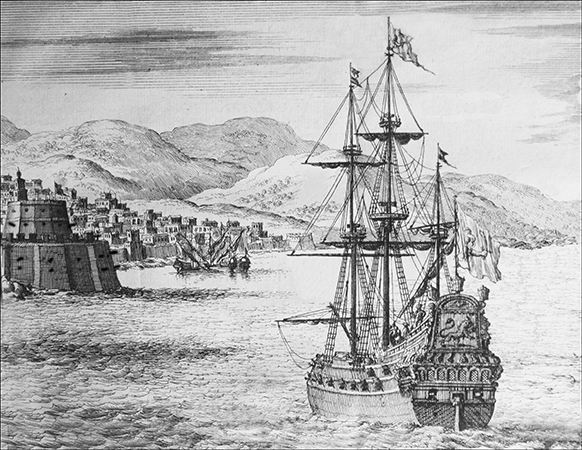This week we continue the story of Helgi Jónsson, a young Icelander who, along with the rest of his family, was captured in the summer of 1627 by corsairs from Salé but who wound up in Algiers.
All the members of Helgi’s family who had been captured were sold into slavery in Salé. Their eventual fates varied, though.
Halldór, Helgi’s uncle (his mother’s brother), suffered mutilation. His mouth, nose and hands were slashed, and he was crippled for the rest of his life. He did, however, survive his captivity. He and his sister (Helgi’s mother) were ransomed by a Dutch merchant, and the two of them were back in Iceland by the end of 1628.
Helgi, remember, had two brothers: an older one named Jón, and a younger one named Héðinn. According to the Icelandic text, “a great sum of money” was offered to ransom Héðinn, but his owner refused to sell him. So Héðinn remained stuck in Salé.
Helgi and Jón were initially sold in the Salé slave market, but both were subsequently brought to Algiers. Exactly how or why this happened is unclear.
There was a lot of traffic between Salé and Algiers at this time, so it is not really very surprising that Helgi and Jón wound up where they did. There is no way to know whether the brothers were auctioned off together of separately in the Salé slave market, or who might have bought them. Perhaps their buyer(s) were Algerines. Those buyers could also have been speculators, though: men who bought slaves at modest prices in Salé and then resold them at a profit in Algiers. Whatever the case, Jón and Helgi both found themselves aboard a ship headed for Algiers.
The sea voyage from Salé was about 1,000 kilometers (675 miles), so the journey took a while. The most dangerous part for the corsairs was the passage through the Strait of Gibraltar, for Spanish warships patrolled that area, always on the lookout for corsair vessels.
The ship (or ships) Helgi and Jón traveled on clearly made the passage successfully, and the brothers found themselves approaching Algiers some days later.
Arriving there would have been an overwhelming experience for them.
As we have seen in previous posts in this series, seventeenth century Algiers presented a quite spectacular sight when seen from the sea. It was located on the north-western horn of a large bay—15 kilometers (9 miles) across—ringed by verdant mountains. The city ascended a mountain slope, tier after tier, up from the harbor to the mountain’s crest, 120 meters (395 feet) above sea level. The tightly packed dwellings were whitewashed frequently (using slave labor), and they gleamed brightly in the Mediterranean sun.
More than one writer of the time described this mass of whitened buildings, framed by luxuriant green hills, as resembling a glittering diamond in an emerald setting.
Helgi likely got his first glimpse of Algiers while standing on the deck of the ship carrying him and his new owner. He would have observed the white, gleaming lozenge of the city in its green frame emerge in the distance when the Algiers bay came into view. As the ship drew closer, the tiers of brilliantly white buildings would seem to rise up out of the sea, higher and higher, until they completely dominated the shoreline, a human-made alabaster mountain more than a kilometer high. Helgi would never have seen anything even remotely like it—neither would any Icelander.
Approaching the harbor, the ship Helgi was on would have passed by an island fortress bristling with cannon. The mole—a long, rocky causeway extending for about 300 meters (close to 1,000 feet)—connected this island fortress with the city itself and served as a breakwater to create a sheltered harbor. This mole was a serious piece of marine architecture and could shelter up to eighty ships.
The harbor was a bustling place, with departing ships loading water, food, munitions, and other supplies, and arriving ships unloading cargo, including newly taken captives. Any corsair ship returning from a successful cruise would fire off its canon in an exultant salvo. Often the shore batteries would fire an excited volley of their own in response. Rowdy, strident crowds would mob the Mole when a successful expedition arrived.
There is no way to know if Helgi and his new owner were aboard one of those triumphantly returning corsair vessels or if their ship merely slipped quietly in. Whatever the case, they would have disembarked on the mole and walked along it through bustling throngs—or crowds—of people into the city.
For a rural Icelander like Helgi, from a remote island where there were not even any towns to speak of, entering urban Salé must have been a shock. Entering Algiers would have been far more of a jolt. The sheer scale of the place was overwhelming. The harbor front stretched for close to two kilometers (a mile and a quarter). A protective city wall, 9 meters (30 feet) high and nearly 3 meters (10 feet) thick, ran the entire length of it, some sections coming right down to the seashore at the harbor front, so that the waves broke against it. Above the massive barrier of this wall, Helgi would have seen the tips of minarets and the long, white slope of the city rising up and up into the sky.
Not only was Algiers huge; it was also home to huge crowds of people. We moderns are used to large cities, with populations in the millions. In the 1620s, there simply were no such cities in Europe. The very largest European cities of this time—Paris, London, Naples—had population of no more than 300,000-400,000. Cities of the next rank—such as Lisbon, Venice, Amsterdam, Rome—had populations of between 100,000-150,000. Algiers had a population of over 100,000 (25,000-30,000 of whom were slaves) making it the second most populated city in the Mediterranean basin; only Naples was larger.
The sheer volume of people would have been a stunning blow. And so would the variegation of crowds: indigenous North Africans, Sub-Saharan Africans, Ottoman Turks, and Europeans from every county imaginable, both renegades and slaves; even some Amerindians and Japanese somehow wound up there, half a world away from their homeland. Algiers had almost seven times the population of Salé, but without having anywhere near seven times the space. The density of population would have beyond anything Helgi—or any Icelander of the time—could have imagined.
We’ll continue the story of what happened to Helgi in Algiers next week.

Corsairs and Captives
Narratives from the Age of the Barbary Pirates
View Amazon listing
The Travels of Reverend Ólafur Egilsson
The story of the Barbary corsair raid on Iceland in 1627
View Amazon listing